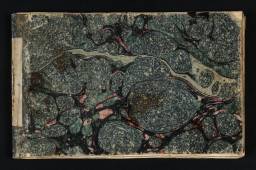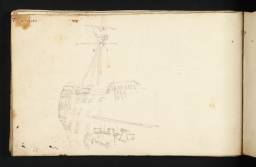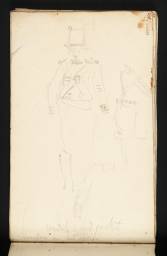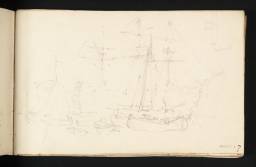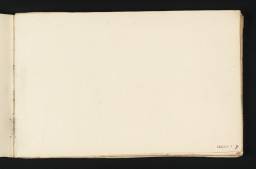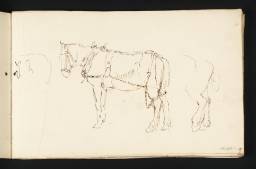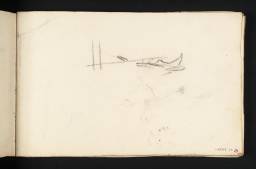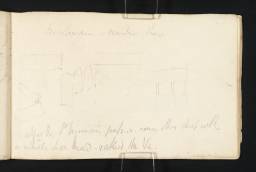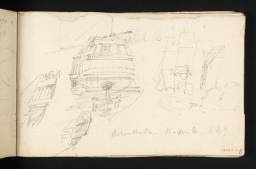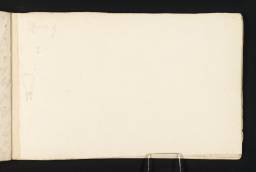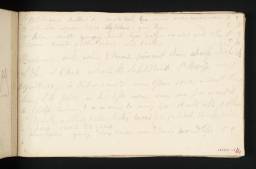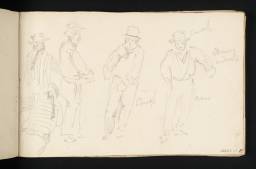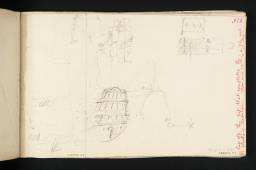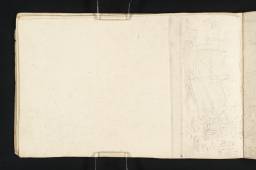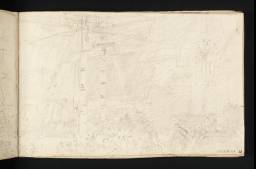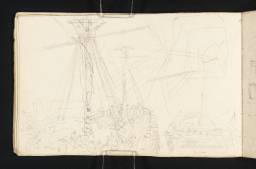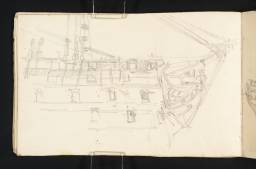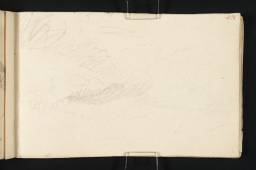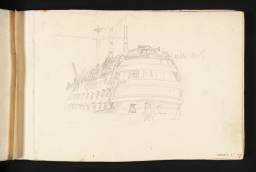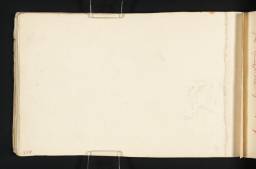Turner Bequest LXXXIX
Pocket book, in blue and pink marbled paper covers
32 leaves of white wove paper made on a double-faced mould
Approximate page size 114 x 184 mm
Made by William Balston and Finch and Thomas Robert Hollingworth at Turkey Mill, Kent, and watermarked ‘J WHATMAN | 1804’. Probably bound by William Dickie at 120 The Strand, London
Inscribed by Turner in ink ‘105 Victory’ on a label on the spine
Endorsed by the Executors of the Turner Bequest in ink ‘No 387 | 24 leaves of pencil sketches’ and signed by Henry Scott Trimmer ‘H.S. Trimmer’ and in pencil by Charles Lock Eastlake ‘C.L.E.’ and John Prescott Knight ‘JPK’ inside front cover. Also inscribed by Arthur Mayger Hind in ink ‘Re-arranged in | what appears to be | original order | 1934, A.M.H.’ inside front cover
32 leaves of white wove paper made on a double-faced mould
Approximate page size 114 x 184 mm
Made by William Balston and Finch and Thomas Robert Hollingworth at Turkey Mill, Kent, and watermarked ‘J WHATMAN | 1804’. Probably bound by William Dickie at 120 The Strand, London
Inscribed by Turner in ink ‘105 Victory’ on a label on the spine
Endorsed by the Executors of the Turner Bequest in ink ‘No 387 | 24 leaves of pencil sketches’ and signed by Henry Scott Trimmer ‘H.S. Trimmer’ and in pencil by Charles Lock Eastlake ‘C.L.E.’ and John Prescott Knight ‘JPK’ inside front cover. Also inscribed by Arthur Mayger Hind in ink ‘Re-arranged in | what appears to be | original order | 1934, A.M.H.’ inside front cover
Accepted by the nation as part of the Turner Bequest 1856
Exhibition history
References
This sketchbook was used to make sketches and studies of the Victory when she returned from the Battle of Trafalgar to Sheerness and Chatham in December 1805. It also contains sketches of some of her crew and diagrams and memoranda of the battle, as well as studies for Turner’s pictures The Battle of Trafalgar, as Seen from the Mizen Starboard Shrouds of the Victory exhibited at Turner’s Gallery in 1806 (Tate N00480) and The Victory Returning from Trafalgar possibly shown at the same time (Yale Center for British Art, New Haven, Connecticut). There are also two sketches of a horse. There is some overlap with the Shipwreck (2) sketchbook (Tate D05428–D5445; D40697–D40700; Turner Bequest LXXXVIII), which must have been used concurrently and also contains a few sketches of the Victory.
Victory’s homeward voyage, with Nelson’s remains on board preserved in brandy, took some seven weeks. Badly damaged by bombardment, having lost her mizzen-mast (the stern-most of three), the top of her main (central) and fore-masts, and forced to endure an ensuing storm, she was first towed to Gibraltar. Eventually on 4 December she arrived off Spithead, passing another veteran of the battle, the Temeraire, which had arrived earlier and was now at anchor.1 On 7 December the press reported that Victory had been declared ‘not in a fit state to proceed ... without considerable repairs’ and that Nelson’s remains might have to be taken overland to London.2 Two days later prospects were more promising as a new mizzen-mast was being fitted.3 In fact jury (temporary) masts were installed at Portsmouth, and on 11 December, with Nelson’s remains still on board, she sailed for Sheerness. Having been held up by contrary winds off the North Foreland, she arrived at the Nore anchorage off Sheerness on 22 December; the next day, undertakers went out to place Nelson’s remains in a proper coffin, which was then transferred to the yacht Chatham and taken to Greenwich for the Admiral’s lying-in-state. On Christmas Day, the flagship reached the Lower Moorings in Long Reach above Sheerness where Turner was soon able to draw her.
Turner was not the only visitor. Navy ships were open to those with the right connections – John Constable had visited and drawn the Victory during her refit at Chatham in 1803 and after Trafalgar the ship was a fashionable tourist destination. Seaman J. Brown wrote, ‘We scarce have room to move, the ship is so full of Nobility coming down from London to see the ship looking at shot holes’.4 Evidence for when and where Turner drew her is mixed but, ultimately, very clear. On 1 July 1825 he wrote to the marine painter J.C. Schetky that he possessed a sketch of the Victory made ‘when she entered the Medway (with the body of Lord Nelson)’.5 This recollection cannot be accurate, as the great man’s remains had been taken off the ship before she entered the river. Turner may have intended to await the arrival of both. If his note ‘15 Sunday’ on folio 32 verso at the back of the book (see D05480) refers to 15 December 1805, which was indeed a Sunday, it might also be the date he expected Victory to appear; she had left Portsmouth four days earlier and he may not have known of the delaying winds. In fact, he did draw her in the Medway at Long Reach, but only at the end of the month, as can be confirmed by the condition in which she appears in his drawings and by the record of works to the ship in her logbooks.6 Meanwhile, he was in London on 27 December 1805, as the Notebook of Mrs (John) Soane states that on that day ‘Mr Turner left a draft of 120.15.0 to be taken care of during his absence in the country’;7 this ‘absence’ must have been his trip to the Medway.
At Long Reach, Victory was submitted to a general strikedown, and stripped of everything including ballast. This was so that she could be warped up-river and into dock at Chatham where she was paid off during January 1806. On 1 January, her upper masts and rigging were removed, and her lower masts were dismantled the next day. Because Turner generally shows her jury-masts and rigging still in place, and indeed climbed to the lookout on the mizzen, his visits to the ship can be dated between Mrs Soane’s note on 27 December and the end of the month.
Turner’s sketches include views of the ship across water and from the dockside as well as on board, sketches of officers and crew, and others indicating his enquiries into the design and position of ships lost in or after the battle – among them the Santissima Trinidad, the huge flagship of the Spanish Admiral Cisneros, the Bucentaure, flagship of the French Admiral Villeneuve and the Redoutable, the French ship under the command of Captain Lucas from whose mizzen-top a marksman fired the shot that killed Nelson. Turner also took notes of the alignments of ships during the battle. He will already have been planning his picture, Battle of Trafalgar, as Seen from the Mizen Starboard Shrouds of the Victory (Tate N00480), which he exhibited in his own Gallery the following year, 1806.8 The sketchbook contains several rough sketches of the chosen viewpoint over poop and quarterdeck, from the jury-rig, as Hamilton observes,9 and also a quite advanced double-page study for it, already including the dying Nelson and other figures (folios 14 verso–15; D41427–D05481; LXXXIX 26). This may have been added to the book as Turner referred to it in the studio, perhaps also, by this time, with access to larger drawings of the ship’s deck, one of which shows Captain Hardy’s cabin knocked out for rebuilding (Tate D08275; Turner Bequest CXXI S).
Like the Waterloo and Rhine and Guards sketchbooks (Tate D12702–D12833; D40663–D40665; Turner Bequest CLX and Tate D13245–D13321; D40907–D40909; Turner Bequest CLXIV), concerned with the Battle of Waterloo, Turner’s Victory and Trafalgar sketches are evidence of his powers of research. They show the importance he attached to sourcing his material on great events of the day as accurately as he could – if not first-hand or on the spot, then from eye-witnesses and participants. Other than the sick and seriously wounded, 250 ordinary seamen and her remaining marines were still on duty on board until 15 January. How many Turner met, and on what authority, we cannot know. But notes on folio 9 verso (D05456) on incidents and ship positions during the fighting are headed ‘Boatswain described this’, indicating a conversation with the Boatswain, William Willmet, and among other officers and men named and described (down to their ‘long [pig] tail’ or ‘good teeth’) on folio 12 (D05462; LXXXIX 14) is the Master, Thomas Atkinson, who would have been an important source as his duties included keeping the ship’s journal and log as well as preparing charts.
One wonders if Turner’s interviewees made their own contributions to the book – perhaps drafting some of the diagrams of ships and battle plans. Altogether, Turner was able to piece together a wealth of detail and incident: ships’ complements of guns (uniquely large in the case of the Santissima Trinidad); colours of sails; markings of flags and signals; ship positions; uniforms and dress; and episodes like the wounding of Nelson’s flag-lieutenant, John Pasco, indicated on folio 11 (D05460; Turner Bequest LXXXIX 13). Woven into his picture along with the death of Nelson himself, they create a rolling narrative in which the central tragedy on board the Victory is surrounded by the events of the battle. Turner’s illustrated key to it (Tate D08266; Turner Bequest CXXI K) shows that it incorporates the individuals mentioned in this sketchbook and more besides.
When Turner revisited the subject of Trafalgar in 1822–4 for King George IV (National Maritime Museum, Greenwich)10 he must have returned to the sketches in this book – for example folio 6 (D05452; Turner Bequest LXXXIX 7) which exerted a misleading effect on the picture by showing the ship riding high in the water11 as she was after strikedown but not during the battle or in normal service. His letter to Schetky, mentioning his drawing of the Victory entering the Medway, was written to request a further drawing of the ship as a source for the picture. He had already obtained ‘the Admiralty or Navy office drawing’. The later picture was to be much larger than the 1806 one and a different composition, with the ship seen from the sea.
The other picture to emerge from the sketchbook was The Victory Returning from Trafalgar, probably shown at Turner’s Gallery in 1806 when it was bought by Walter Fawkes (Yale Center for British Art, New Haven, Connecticut).12 Whether this really depicts the Victory or a generic ship of the line, and how if the former she can be returning from Trafalgar when she did not pass the Needles off the Isle of Wight, shown in the background, and appears undamaged with her flags flying normally rather than at half-mast in tribute to Nelson has been much discussed, notably by Eric Shanes.13 As Shanes implies, there is no need to treat the picture as a literal representation of the Victory as she really was at that time, battle-worn and broken as Turner well knew. Rather than portray the sadder truth, Turner restored her to her prime – in effect to what she when she set out from the Solent into the Channel on her way to Trafalgar. But that she is the Victory, and that her origins belong in this sketchbook, seems proved beyond doubt by the presence of port and starboard views linked by a sketch of a cloudy sky similar to that in the picture (folios 17, 18, 17 verso; D05487, D05489, D05488; Turner Bequest 29, 30).
Turner put his knowledge of the ship positions at Trafalgar, as set out in this sketchbook, to one further imaginative use; in his watercolour Yarmouth Sands, Norfolk of about 1830 (Fitzwilliam Museum, Cambridge).14 On the sands below the Nelson Column erected there in 1817–19, sailors use ship models to re-enact Nelson’s victories, principally Trafalgar when his famous ‘Nelson touch’ broke the French line. And the Temeraire, which Turner did not see at Sheerness in 1805 but included by proxy in his sketches whenever she was needed, became the subject of The Fighting ‘Temeraire’, Tugged to her Last Berth to be Broken Up in the Royal Academy in 1839 (National Gallery, London).15
Log of Captain Harvey of the Temeraire, in Judy Egerton, Turner: The Fighting Temeraire, exhibition catalogue, National Gallery, London 1995, p.33.
Turner to J.C. Schetky, 3 December 1823; in John Gage ed., Collected Correspondence of J.M.W. Turner, Oxford 1980, p.90 no.101.
For data from the logbooks (National Archives, Kew) and for assistance and comments on the movements of Victory and on Turner’s drawings, this writer is indebted to Eric Shanes whose forthcoming biography of Turner will add further detail.
Mrs Soane’s Notebook cited by Helen Dorey, John Soane and J.M.W. Turner: Illuminating a Friendship, exhibition catalogue, Sir John Soane’s Museum, London 2007, p.9.
Technical Notes
Acknowledgements:
The writer is grateful to Pieter van der Merwe and Eric Shanes for reading this material and for their assistance and advice.
How to cite
David Blayney Brown, ‘Nelson sketchbook 1805’, sketchbook, August 2010, in David Blayney Brown (ed.), J.M.W. Turner: Sketchbooks, Drawings and Watercolours, Tate Research Publication, December 2012, https://www

